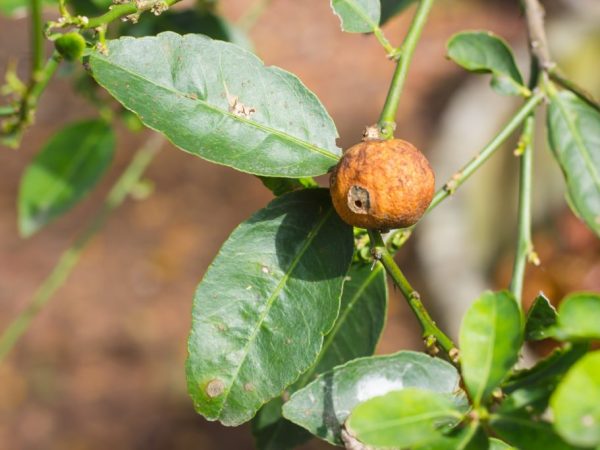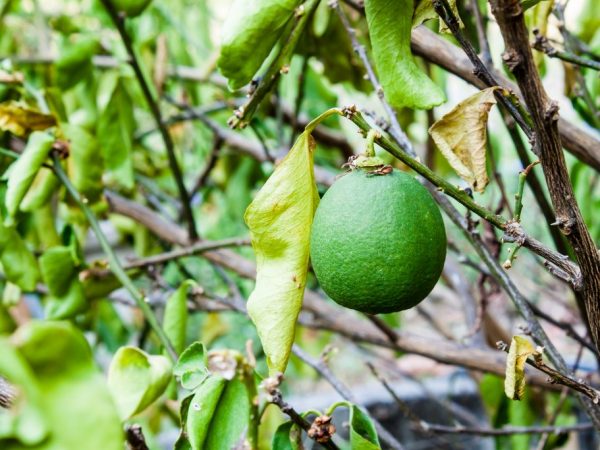Why does lemon dry
Home-grown lemons require quality care. With any errors in the content, the culture does not bloom, get sick and does not bear fruit. Often the lemon dries up and its leaves fall off. To keep a houseplant alive, it is important to identify the factors that precede such problems and take appropriate action.

Why does lemon dry
Causes of lemon drying
Most of the reasons for the yellowing and drying of the leaves of the lemon tree lie in the errors in the care of the grown crop. When a small amount of leaves dry on a plant, do not worry: this is often a sign of seasonal rejuvenation of the deciduous mass of the plant, especially in mature trees.
If citrus sheds half of the deciduous mass or more, it is worth revising the features of the culture content at home.
Lemon leaves can dry out for the following reasons:
- poor lighting (citrus suffers from excess or lack of sunlight);
- insufficient watering or excess moisture in the soil;
- sudden changes in temperature;
- dry indoor air;
- lack or excess of nutrients contained in the soil.
Leaves fall off if the indoor tree has been infected with diseases or suffers from pests. The sooner the signs of damage and the factors preceding it are identified, the faster and more successful the treatment will be. It will not be possible to revive the plant only if the lemon is completely dry.
How to save a lemon tree
There are more chances to save a home-grown crop with the timely detection of signs of drying out of the leaves. When the lemon is just starting to dry, it still resists the effects of harmful factors - it will be able to revive it faster.
All measures for the improvement of indoor citrus are also preventive methods, because the treatment and prevention of damage to the leaf plates are performed by similar actions. The only exception is the infection of the plant with fungal and viral diseases, as well as the attack of pests.
It will be possible to cure citrus from diseases at home using copper-containing formulations.
It is impossible to fight Molsecco's disease. For such a pathology, effective means and methods of treatment do not yet exist.
Organization of correct lighting
Lemon is a tropical plant. He loves moisture and sunlight. The light should be diffused, characteristic of the dense thickets of the tropical jungle. Direct sunlight leaves burns on the leaf plates, which is why their surface begins to transform, becomes dry and rough.
To save a house tree, you will have to take several important measures. The citrus owner needs:
- Organize 12 hours of daylight hours. Supplementing is carried out with phytolamps.
- Install the container on the south, south-east or south-west windows.
- Protect the deciduous mass from direct sunlight with a cloth or special reflective foil overlays (they are attached to window panes).
All sun-damaged foliage will have to be removed. Dried leaves cannot be restored. It is easier to make room for the germination of young green mass.
Correction of errors in the organization of irrigation

Overflow can lead to root rot
Lemons love moisture and react poorly to lack and excess. The plant is watered in small portions of warm water, avoiding the accumulation of excess liquid in the pan. They are guided by the state of the soil in the pot. Citrus is watered as soon as the earthy clod becomes dry.
With overflows, the roots of the culture suffer. They rot and gradually die off, depriving the tree of nutrients. As a result, the structure and color of the foliage changes, it dries and falls off. With such signs, they act decisively:
- extract the citrus from the pot;
- carefully remove the earthen lump and rinse the roots with running warm water;
- examine the root system for damaged tissues (all rotten processes are removed);
- treat the cuts with charcoal or other antiseptics.
After the performed manipulations, the citrus roots are dried for up to 30 minutes, and the lemon is planted in a new substrate with a good drainage system (up to 1/3 of the total volume of the pot).
Temperature normalization
With sudden cold snaps and frostbite, the lemon tree can quickly lose its leaves. Even an ordinary draft can have a detrimental effect on culture.
When exposed to critical temperatures, they stabilize the indoor microclimate. The favorable temperature for citrus content is 18-22 ° C. With careful care, the tree will grow quickly and build up new healthy deciduous mass.
Air humidification
If citrus foliage begins to dry around the edge and curl, it suffers from dry air. The normal moisture content for the content of this culture is 60-70%. With any deviations, she is sick.
Freshening a flower in a pot will not be difficult. The following measures are beneficial:
- Spraying the foliage and tree trunk regularly with warm water and rubbing the foliage daily.
- Covering heating devices with a thick cloth or foil: they contribute to dry air near adjacent windows.
- Installing vessels with water next to a tree.
The roots of the plant are protected from the effects of dry air by spreading sphagnum moss or a piece of wet tissue near the trunk circle.
Correct feeding
If dry tissue is visible only at the ends of the leaf plates, and all the veins look healthy, this is a sign of a lack of nutrients in the soil. With an overabundance of them, the foliage falls off, not having time to dry.
Until the plant is completely dry, appropriate measures should be taken. For citrus fruits, a complex mineral composition is introduced. It is better not to use ordinary mineral fertilizers for fruit crops.
Pest control
There are a number of diseases and pests that cause citrus to shed its foliage.
Most often, the tips of the leaves of the indoor lemon dry out due to the spider mite. A characteristic sign of infection is drying of not only the leaves, but also the branches of the plant. A thin cobweb and small black dots are located on the leaf plates. So that the indoor tree does not completely dry out due to the detrimental effect of the tick, they get rid of it. There are several effective treatment options:
- processing of deciduous mass with an aqueous solution of laundry soap;
- backlighting with an ultraviolet lamp;
- the use of insecticides.
The scabbard is also dangerous for the lemon tree. When it attacks, small growths appear on the leaves, which quickly grow, destroying the leaf plate. As a result, the lemon leaves dry and fall off. The shield is fought with soapy water and insecticides.
Conclusion
If the tips of the leaves dry on the lemon, the reason should be sought in the lack of caring for the indoor tree. It will be possible to revive the plant only by normalizing its content: by properly organizing watering, air temperature and humidity, fertilizing, etc. If the lemon is actively dropping foliage, check the condition of the roots and the presence of signs of infection with diseases and pests.


